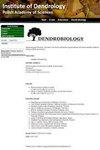地中海树种monspessulanum侵入了柏林的城市绿地
IF 1.8
4区 农林科学
Q2 FORESTRY
引用次数: 5
摘要
由于一些引进树种的生物入侵对生物多样性构成了重大威胁,因此早期发现入侵风险对于管理现有和未来的种植以及减轻入侵的负面影响非常重要。宏碁是一种欧洲树种,分布在地中海和亚地中海地区。由于其高抗旱性,它被认为很好地适应了气候变化,是一种很有前途的城市种植树木。这项研究旨在确定入侵风险是否与该物种自然范围以外的城市种植有关。在德国柏林,人们使用了罕见的老植物A.monspesulanum作为模型来研究城市植物是否会成为温带气候城市的入侵焦点。为此,对栽培树木的周围环境进行了自然再生检查,并确定了自然再生个体的数量和高度以及它们与母树的距离。宏碁在柏林首次种植273年后开始传播。采样的四种植物中的每一种都有当地的自发种群,主要分布在松散的、半荫蔽的人为树篱和森林斑块上。共检测到814个自发个体,最大高度为4.5米。与下一棵亲本树的最大距离为106米。然而,大多数个体生长在亲本树的树冠下方或附近。研究结果表明,增加蒙斯苏拉的种植可以在其原生范围以外的城市引发入侵过程。然而,在与柏林环境条件相似的城市,预计不会出现城市种植带来的负面入侵影响。因此,该物种不被认为是入侵物种。尽管有几十年的传播期,但自发种群仅限于繁殖源附近,被入侵的城市绿地的保护价值较低。作为一个积极的影响,在这种环境中,a.monspesulanum的自然再生可以提高城市森林斑块对气候变化的抵御能力。然而,应监测进一步的传播,并避免在有干燥草原的岩石场地附近种植。本文章由计算机程序翻译,如有差异,请以英文原文为准。
The Mediterranean tree Acer monspessulanum invades urban greenspaces in Berlin
Because biological invasions by some introduced tree species pose a major threat to biodiversity, early detection of invasion risks is important for managing existing and future plantings and mitigating negative impacts of invasions. Acer monspessulanum is a European tree species with a large Mediterranean and sub-Mediterranean range. Due to its high drought resistance, it is considered well adapted to climate change and a promising future tree for urban plantings. This study aimed to determine whether invasion risks are associated with plantings in cities outside the species’ natural range. Rare old plantings of A. monspessulanum in Berlin, Germany, were used as a model to investigate whether urban plantings can be invasion foci in cities with a temperate climate. For this purpose, the surroundings of cultivated trees were examined with regard to natural regeneration and the number and height of naturally regenerated individuals and their distance from the parent tree were determined. Acer monspessulanum started to spread 273 years after the first cultivation in Berlin. Each of the sampled four plantings had local spontaneous populations, mostly colonizing loose, semi-shaded anthropogenic hedges and forest patches. A total of 814 spontaneous individuals were detected, with a maximum height of 4.5 m. The maximum distance to the next parent tree was 106 m. However, most individuals grew below or close to the canopy of parent trees. The results indicate that increased planting of A. monspessulanum can induce invasion processes in cities beyond its native range. However, negative invasion impacts from urban plantings are not to be expected in cities with similar environmental conditions as Berlin. Therefore, the species is not considered invasive. Despite a decades-long spread period, the spontaneous populations were confined to the adjacency of propagule sources and the invaded urban greenspaces had a low conservation value. As a positive effect, natural regeneration of A. monspessulanum in such settings could increase the resilience of urban forest patches to climate change. However, further spread should be monitored and plantings near rocky sites with dry grasslands of conservation concern should be avoided.
求助全文
通过发布文献求助,成功后即可免费获取论文全文。
去求助
来源期刊

Dendrobiology
农林科学-林学
CiteScore
2.20
自引率
11.10%
发文量
17
审稿时长
>12 weeks
期刊介绍:
Dendrobiology publishes original research articles and review articles related to the biology of trees and shrubs.
 求助内容:
求助内容: 应助结果提醒方式:
应助结果提醒方式:


